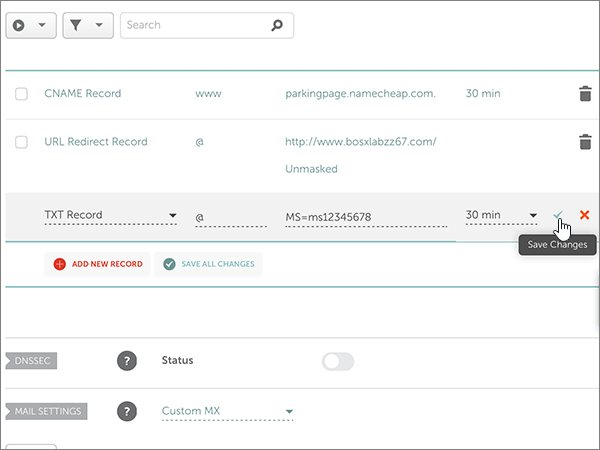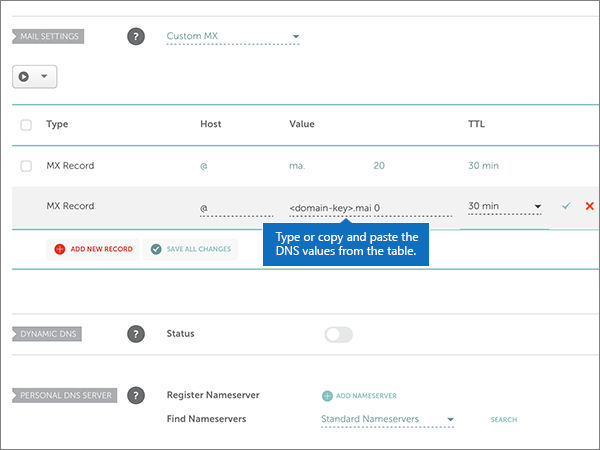Connect your DNS records at Namecheap to Microsoft 365
Check the Domains FAQ if you don't find what you're looking for.
If Namecheap is your DNS hosting provider, follow the steps in this article to verify your domain and set up DNS records for email, Microsoft Teams, and so on.
After you add these records at Namecheap, your domain will be set up to work with Microsoft services.
Note
Typically it takes about 15 minutes for DNS changes to take effect. However, it can occasionally take longer for a change you've made to update across the Internet's DNS system. If you're having trouble with mail flow or other issues after adding DNS records, see Troubleshoot issues after changing your domain name or DNS records.
Add a TXT record for verification
Before you use your domain with Microsoft, we have to make sure that you own it. Your ability to log in to your account at your domain registrar and create the DNS record proves to Microsoft that you own the domain.
Note
This record is used only to verify that you own your domain; it doesn't affect anything else. You can delete it later, if you like.
To get started, go to your domains page at Namecheap by using this link. You'll be prompted to Sign in and Continue.

On the landing page, under Account, choose Domain List from the drop-down list.

On the Domain List page, select the domain you want to edit, and then select Manage.

Select Advanced DNS.

In the HOST RECORDS section, select ADD NEW RECORD.

In the Type drop-down, select TXT Record.
Note
The Type drop-down automatically appears when you select ADD NEW RECORD.

In the boxes for the new record, type or copy and paste the values from the following table.
(Choose the TTL value from the drop-down list.)
Type Host Value TTL TXT @ MS=ms XXXXXXXX
Note: This is an example. Use your specific Destination or Points to Address value here, from the table. How do I find this?30 min 
Select the Save Changes (check mark) control.

Wait a few minutes before you continue, so that the record you just created can update across the Internet.
Now that you've added the record at your domain registrar's site, you'll go back to Microsoft and request the record. When Microsoft finds the correct TXT record, your domain is verified.
To verify the record in Microsoft 365:
In the admin center, go to the Settings > Domains.
On the Domains page, select the domain that you're verifying, and select Start setup.

Select Continue.
On the Verify domain page, select Verify.
Note
Typically it takes about 15 minutes for DNS changes to take effect. However, it can occasionally take longer for a change you've made to update across the Internet's DNS system. If you're having trouble with mail flow or other issues after adding DNS records, see Troubleshoot issues after changing your domain name or DNS records.
Add an MX record so email for your domain will come to Microsoft
To get started, go to your domains page at Namecheap by using this link. You'll be prompted to Sign in and Continue.

On the landing page, under Account, choose Domain List from the drop-down list.

On the Domain List page, select the domain that you want to edit, and then select Manage.

Select Advanced DNS.

In the MAIL SETTINGS section, select Custom MX from the Email Forwarding drop-down list.
(You may have to scroll down.)

Select Add New Record.

In the boxes for the new record, type or copy and paste the values, from the following table.
(The Priority box is the unnamed box to the right of the Value box. Choose the TTL value from the drop-down list.)
Type Host Value Priority TTL MX Record @ <domain-key>.mail.protection.outlook.com.
This value MUST end with a period (.)
Note: Get your <domain-key> from your Microsoft account. How do I find this?0
For more information about priority, see What is MX priority?30 min 
Select the Save Changes (check mark) control.

If there are any other MX records, use the following two-step process to remove each of them:
First, select Delete (trash can) for the record that you want to remove.

Second, select Yes to confirm the deletion.

Remove all MX records except for the one that you added earlier in this procedure.
Add the CNAME record required for Microsoft
To get started, go to your domains page at Namecheap by using this link. You'll be prompted to Sign in and Continue.

On the landing page, under Account, choose Domain List from the drop-down list.

On the Domain List page, select the domain that you want to edit, and then select Manage.

Select Advanced DNS.

In the HOST RECORDS section, select ADD NEW RECORD.

In the Type drop-down, select CNAME Record.
Note
The Type drop-down automatically appears when you select ADD NEW RECORD.

In the empty boxes for the new record, select CNAME for the Record Type, and then type or copy and paste the values from the first row in the following table.
Type Host Value TTL CNAME autodiscover autodiscover.outlook.com.
This value MUST end with a period (.)Automatic 
Select the Save Changes (check mark) control.

Add a TXT record for SPF to help prevent email spam
Important
You cannot have more than one TXT record for SPF for a domain. If your domain has more than one SPF record, you'll get email errors, as well as delivery and spam classification issues. If you already have an SPF record for your domain, don't create a new one for Microsoft. Instead, add the required Microsoft values to the current record so that you have a single SPF record that includes both sets of values.
To get started, go to your domains page at Namecheap by using this link. You'll be prompted to Sign in and Continue.
On the landing page, under Account, choose Domain List from the drop-down list.

On the Domain List page, select the domain that you want to edit, and then select Manage.

Select Advanced DNS.

In the HOST RECORDS section, select ADD NEW RECORD.

In the Type drop-down, select TXT Record.
Note
The Type drop-down automatically appears when you select ADD NEW RECORD.

In the boxes for the new record, type or copy and paste the following values from the following table.
(Choose the TTL value from the drop-down list.)
Type Host Value TTL TXT @ v=spf1 include:spf.protection.outlook.com -all
Note: We recommend copying and pasting this entry, so that all of the spacing stays correct.30 min 
Select the Save Changes (check mark) control.

Advanced option: Microsoft Teams
Only select this option if your organization uses Microsoft Teams. Teams needs 4 records: 2 SRV records for user-to-user communication, and 2 CNAME records to sign-in and connect users to the service.
Add the two required SRV records
To get started, go to your domains page at Namecheap by using this link. You'll be prompted to sign in.

On the landing page, under Account, choose Domain List from the drop-down list.

On the Domain List page, select the domain that you want to edit, and then select Manage.

Select Advanced DNS.

In the HOST RECORDS section, select ADD NEW RECORD.

In the Type drop-down, select SRV Record.
Note
The Type drop-down automatically appears when you select ADD NEW RECORD.

In the empty boxes for the new records, type or copy and paste the values from the first row in the following table.
Service Protocol Priority Weight Port Target TTL _sip _tls 100 1 443 sipdir.online.lync.com.
This value MUST end with a period (.)Automatic _sipfederationtls _tcp 100 1 5061 sipfed.online.lync.com.
This value MUST end with a period (.)Automatic 
Select the Save Changes (check mark) control.

Add the other SRV record by choosing the values from the second row of the table.
Note
Typically it takes about 15 minutes for DNS changes to take effect. However, it can occasionally take longer for a change you've made to update across the Internet's DNS system. If you're having trouble with mail flow or other issues after adding DNS records, see Troubleshoot issues after changing your domain name or DNS records.
Add the two required CNAME records for Teams
In the HOST RECORDS section, select ADD NEW RECORD.

In the Type drop-down, select CNAME.
Note
The Type drop-down automatically appears when you select ADD NEW RECORD.

In the empty boxes for the new records, type or copy and paste the values from the first row in the table.
Type Host Value TTL CNAME sip sipdir.online.lync.com.
This value MUST end with a period (.)Automatic CNAME lyncdiscover webdir.online.lync.com.
This value MUST end with a period (.)Automatic 
Select the Save Changes (check mark) control.

Add the other CNAME record by choosing the values from the second row of the table.
Note
Typically it takes about 15 minutes for DNS changes to take effect. However, it can occasionally take longer for a change you've made to update across the Internet's DNS system. If you're having trouble with mail flow or other issues after adding DNS records, see Troubleshoot issues after changing your domain name or DNS records.
Advanced option: Intune and Mobile Device Management for Microsoft 365
This service helps you secure and remotely manage mobile devices that connect to your domain. Mobile Device Management needs two CNAME records so that users can enroll devices to the service.
Add the two required CNAME records for Mobile Device Management
To get started, go to your domains page at Namecheap by using this link. You'll be prompted to sign in.

On the landing page, under Account, choose Domain List from the drop-down list.

On the Domain List page, select the domain that you want to edit, and then select Manage.

Select Advanced DNS.

In the HOST RECORDS section, select ADD NEW RECORD.

In the Type drop-down, select CNAME Record.
Note
The Type drop-down automatically appears when you select ADD NEW RECORD.

In the empty boxes for the new records, type or copy and paste the values from the first row in the table.
Type Host Value TTL CNAME enterpriseregistration enterpriseregistration.windows.net.
This value MUST end with a period (.)Automatic CNAME enterpriseenrollment enterpriseenrollment-s.manage.microsoft.com.
This value MUST end with a period (.)Automatic 
Select the Save Changes control.

Add the other CNAME record by choosing the values from the second row of the table.
Note
Typically it takes about 15 minutes for DNS changes to take effect. However, it can occasionally take longer for a change you've made to update across the Internet's DNS system. If you're having trouble with mail flow or other issues after adding DNS records, see Troubleshoot issues after changing your domain name or DNS records.